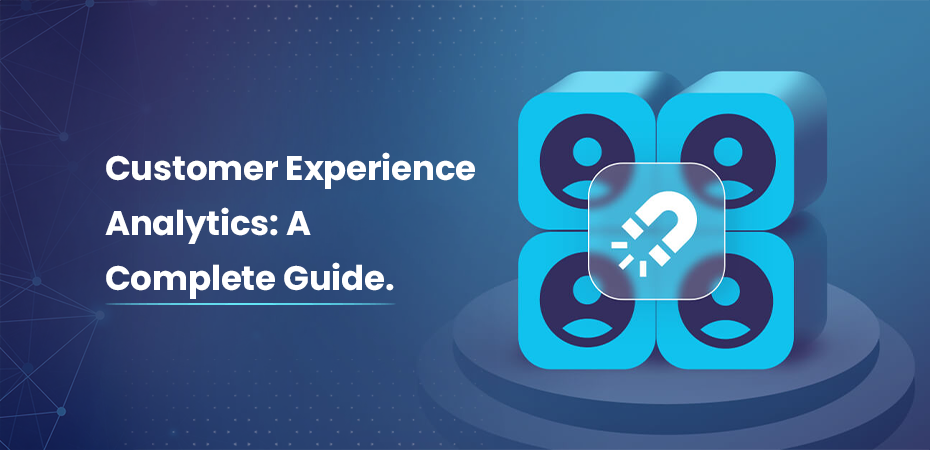Customer Experience Analytics: A Complete Guide



Introduction
In today’s online world, businesses that focus on making customers happy have a big advantage. People want smooth, fast, and personal experiences when they interact with a company. This is where customer experience (CX) analytics helps.
CX analytics means collecting and studying customer data (analytics) to improve their experience. It helps businesses keep their customer base happy, build loyalty, and grow. Since more people now interact with businesses online, companies—especially those working with a digital marketing agency—should use SEO services in New York and other places to improve customer connections.
This guide will explain CX analytics in a simple way. You’ll learn about key customer experience measurements, how AI tools help, and what to expect in the future. Whether you’re a small business or a large company, understanding CX analytics can help you serve your customers better and stand out from competitors.
Understanding Customer Experience Analytics
What is Customer Experience Analytics?
Customer experience (CX) analytics is the process of collecting and studying data about how customers interact with a business. It helps companies learn what customers like, what they don’t like, and what problems they face. This information helps businesses improve their services and create better experiences.
Key Components of CX Analytics:
- Customer Journey Analysis – This means tracking a customer’s path from the first time they hear about a business to when they make a purchase. It helps businesses see where customers might face problems.
- Sentiment Analysis – This is about understanding customer sentiments (feelings). Businesses analyze reviews, surveys, and social media comments to know if people are happy or unhappy.
- Behavioral Analytics – This tracks what customers do on websites, apps, and other platforms. It helps businesses see what people click on, what they buy, and how they move through a website.
- Predictive Analytics – Using AI and smart tools, businesses can guess what customers might do next. This helps companies offer better services before problems arise.
Unlike old-fashioned customer feedback, analytics for customer experience provides real-time insights. This means businesses can quickly find problems and improve customer satisfaction using real customer data analysis.
The Importance of Customer Experience Analytics in Business Growth
Improves Customer Retention
When customers are happy, they stay with a business for a long time. Customer Experience analysis helps companies find problems that may make customers leave. By fixing these issues quickly, businesses can keep their customers satisfied and loyal.
Enhances Brand Reputation
A good customer experience makes people say nice things about a business. Thus, companies use analytics to improve customer engagement and get more positive reviews. Happy customers recommend businesses to others, which helps the brand grow and become more popular.
Drives Revenue Growth
When businesses understand their customers better, they can offer services and products that match their needs. CX analytics helps companies create more personal experiences, making customers feel valued. This leads to more sales, repeat purchases, and long-term customers who bring in more revenue.
Strengthens Competitive Edge
Businesses that use CX analytics stay ahead of their competitors. By improving customer interactions, providing fast support, and solving problems quickly, companies can offer a better experience than others in the market. This makes customers choose them over competitors.
In short, CX analytics helps businesses keep customers happy, grow their brand, increase sales, and stay ahead of competitors. It allows companies to make data-driven decisions based on real experiential data, leading to long-term success.
Key Metrics in Customer Experience Analytics
Net Promoter Score (NPS)
This measures how loyal customers are. Businesses ask customers how likely they are to recommend the company to others. A high score means customers are happy and willing to spread the word.
Customer Satisfaction Score (CSAT)
This tells how satisfied customers are with a product, service, or specific interaction. Businesses usually ask customers to rate their experience. A high CSAT score means customers are happy with what they received.
Customer Effort Score (CES)
This measures how easy it is for customers to solve their problems. If customers have to put in too much effort to get help or complete a task, they might leave. A lower effort score means a smoother experience.
Churn Rate & Retention Metrics
Churn rate shows how many customers stop using a company’s services. Retention rate shows how many stay. A reduced churn rate and higher retention mean customers are happy and loyal.
Customer Lifetime Value (CLV)
This estimates how much money a customer will spend on a business over time. A high CLV means customers keep coming back, making the business more successful.
These metrics help businesses understand their customers and use data analytics to improve customer experience.
Customer Experience Analytics: Tools and Technologies
AI-Driven CX Insights
AI tools help businesses understand customer behavior. These tools study data, find patterns, and predict what customers might do next. This helps companies improve their customer services with data analytics and solve problems before they happen.
Heatmaps & Behavior Tracking
Heatmaps show where people click, scroll, and spend the most time on a website. Tools like Hotjar help businesses see how users interact with their site. This helps companies find problems and make their websites easier to use.
Sentiment Analysis & Customer Feedback Tools
Customer feedback tools analyze what people say in reviews, surveys, and social media. Platforms like Qualtrics and Medallia help businesses understand if customers are happy or unhappy. This way, companies can fix issues and use data to improve customer experience.
CRM & CX Analytics Integration
CRM (Customer Relationship Management) software helps businesses keep track of customer interactions. Platforms like Salesforce and HubSpot combine customer data with CX analytics. This allows companies to offer more personalized services, making customers feel valued and improving their overall experience.
These tools help businesses understand customers better, improve websites, collect feedback, and create a smooth and enjoyable experience. By using the right technology, companies can keep customers happy and grow successfully.
How to Implement an Effective CX Analytics Strategy
Step 1: Collect the Right Data
Start by gathering customer data from different sources. This includes website visits, social media interactions, emails, and customer service chats. The more data you collect, the better you can understand customer needs and behaviors.
Step 2: Analyze and Interpret Customer Interactions
Once you have the data, use analytics tools to study customer behavior. Look for patterns and trends. For example, see what pages customers visit the most, what products they prefer, or where they face problems. This helps businesses understand what is working and what needs improvement.
Step 3: Personalize Customer Experiences
Use customer data to create personalized experiences. Send customized emails, recommend products based on past purchases, and offer special deals based on customer preferences. When businesses make customers feel special, they are more likely to return.
Step 4: Take Action Based on Insights
The final step is to use the insights to improve customer experiences. If data shows customers are struggling to find products, make website navigation easier. If reviews highlight poor customer service, train the team to provide better support. Making these changes based on data will keep customers happy and improve business success.
By following these steps, businesses can create a strong CX campaign that leads to happier customers, better engagement, and long-term growth.
The Role of AI and Machine Learning in CX Analytics
Predictive Analytics
AI helps businesses predict what customers might do next. By studying past behavior, AI can forecast trends and issues before they happen. This allows companies to fix problems early and improve customer satisfaction.
AI Chatbots & Automation
AI-powered chatbots provide instant customer support. They answer common questions, assist with orders, and solve problems quickly. Automation also helps businesses streamline tasks, making customer interactions faster and more efficient.
Personalization & Recommendations
AI analyzes data about customer experience to offer personalized content and product recommendations. If a customer buys a product, AI suggests similar items they might like. This makes shopping easier and increases customer satisfaction.
AI and machine learning make CX analytics smarter by improving customer support, predicting trends, and personalizing experiences. Businesses using AI can better understand customers and create smoother, more engaging interactions.
Overcoming Challenges in CX Analytics
Data Silos and Integration Issues
One of the biggest challenges businesses face is scattered data across different platforms. When customer data is stored separately in various systems, it becomes difficult to get a complete view of the customer journey. Companies need to ensure all data sources are connected, allowing seamless data sharing and better customer insights.
Ensuring Data Privacy and Compliance
With strict data protection laws like GDPR and CCPA, businesses must handle customer data responsibly. Companies should have strong policies to protect customer information, obtain proper consent, and ensure compliance with legal standards. This builds trust and keeps customer data safe.
Interpreting and Acting on Insights Effectively
Collecting customer data is not enough; businesses must also use it correctly. Companies should focus on analyzing data to gain useful customer experience insights and take meaningful actions. Instead of just storing information, businesses should improve customer service, enhance products, and personalize experiences based on the insights they receive.
Future Trends in Customer Experience Analytics
Real-Time CX Analytics
More businesses are moving towards real-time analytics, allowing them to track customer behavior instantly. This helps companies respond quickly to customer needs, solve issues immediately, and provide better experiences.
Hyper-Personalization Through AI
AI and machine learning are making personalization even more advanced. Businesses will use AI to analyze customer preferences in detail and offer highly personalized recommendations, promotions, and experiences.
Voice and Conversational Analytics
With the rise of voice assistants like Alexa, Siri, and Google Assistant, businesses are starting to analyze voice interactions. Conversational AI will play a bigger role in customer service, helping businesses understand customer needs through voice commands and chatbots.
By embracing these trends, businesses can stay ahead in CX analytics and offer better customer experiences.
Conclusion
Customer experience analytics isn’t just about gathering data—it’s about transforming insights into actions that build strong, lasting customer relationships. Businesses that embrace CX analytics can boost satisfaction, increase loyalty, and drive long-term growth. In today’s competitive market, understanding your customers and delivering personalized, seamless experiences is the key to staying ahead.
Hiring a CX analyst can prove to be beneficial as they help businesses analyze customer data, identify pain points, and implement strategies to enhance customer satisfaction and loyalty. A Customer Experience analyst uses advanced analytics tools to track customer behavior, predict trends, and provide actionable insights for improvement. By leveraging their expertise, businesses can create personalized experiences, boost retention, and stay ahead in the competitive market.
If you want to elevate your digital presence and improve customer engagement, investing in SEO Expert New York is a smart move. A trusted New York SEO services provider can help optimize your Customer Experience analytics solutions, ensuring you reach the right audience and make a lasting impact. By combining data-driven insights with expert SEO, you can create an unbeatable customer experience that fuels your business success.
Frequently Asked Questions (FAQs)
Customer service refers to direct interactions between a company and its customers, while customer experience encompasses the entire customer journey and perception of the brand.
Small businesses can use free or affordable tools like Google Analytics, social media insights, and customer surveys to track and improve CX.
Popular tools include Google Analytics, Hotjar, Qualtrics, Salesforce, and AI-driven solutions like IBM Watson and Adobe Analytics.
AI enhances CX analytics by offering predictive insights, automating responses through chatbots, and personalizing customer interactions.
Businesses should continuously monitor CX data in real-time while conducting in-depth quarterly reviews to optimize strategies.